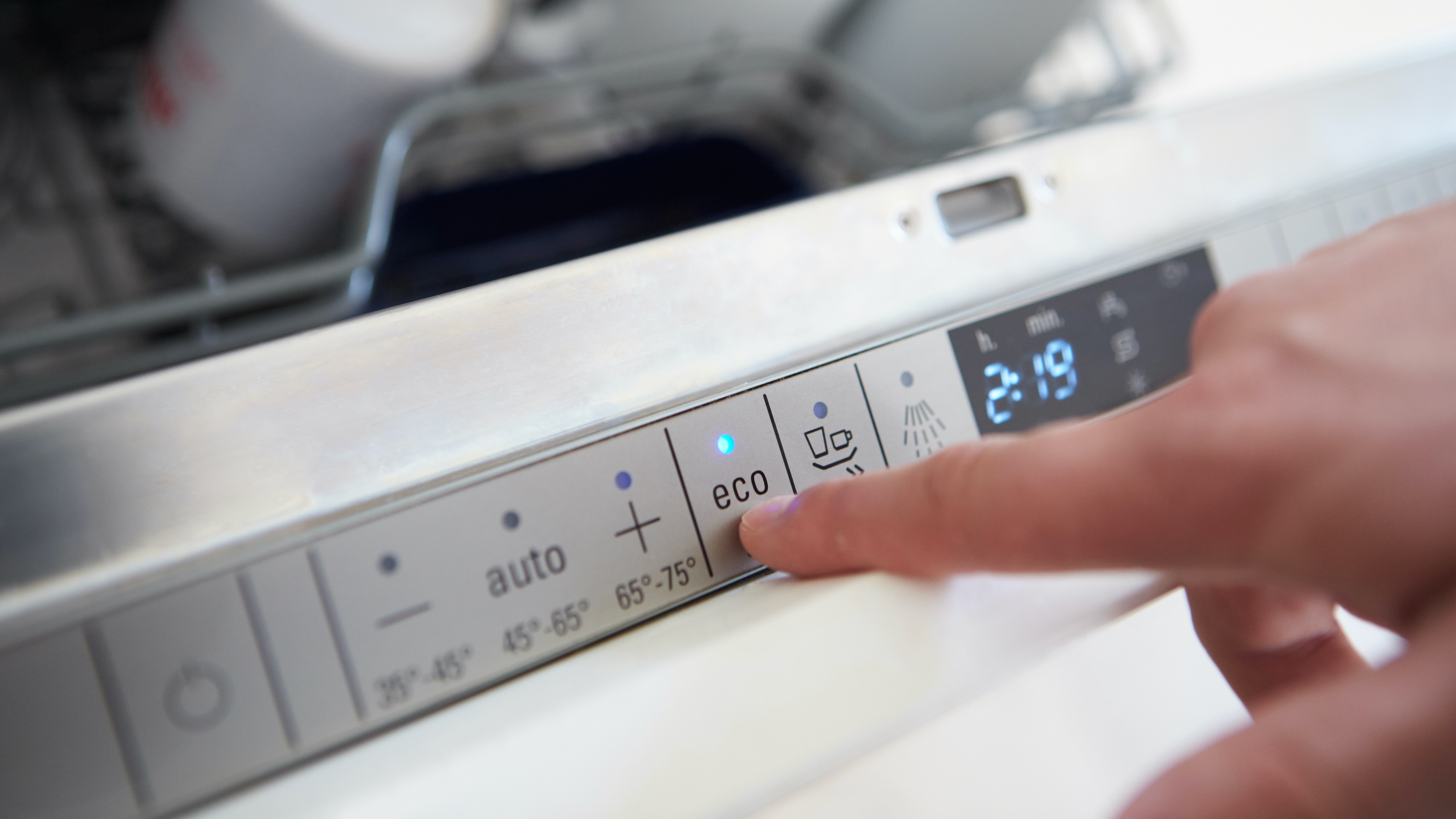How much does it cost to run a dishwasher? Plus, ways to make it cheaper
We've worked out the cost to run a dishwasher per cycle and per year, and found ways you can save on cleaning the dishes.

Preventer of post-dinner squabbles, dishwashers bring harmony to many homes across America, but how much do they cost to run? Well, they're more cost-effective than doing the job by hand, as we shall see, but there may be ways to save further.
If you've given up doing the dishes by hand, you're saving yourself more than just time. "Most people think that a dishwasher will use a lot of water. However, the average kitchen sink will hold about 4.4 gallons of water," explains Helen Haider, Head of Marketing Fisher & Paykel. When you get through two or three bowls full of fresh hot water, you could easily be using 13 gallons at a time.
By comparison, the best dishwashers with Energy Star approval use 3.5 gallons of water at mos. That water needs to be heated, so when you compare like for like, it's easy to see where energy savings can be made. As well as running costs, you should look into other essential factors when considering your next purchase, such as the quietest and largest dishwashers that will make chores more streamlined.
You can further cut the cost of running a dishwasher by following some essential tips. First, though, here's a breakdown of the average running cost you should expect.
How much does it cost to run a dishwasher?
Dishwashers use an average of 253 kWh of electricity per year and cost $37.95 to run.
This average kWh/yr annual energy use figure is based on 827 residential dishwasher models put through standardized testing by the government-backed Energy Star scheme. The energy use of each dishwasher was measured under typical conditions and included the machine energy used during the cycle, the energy used by the water heater to heat the water, and the energy used in standby mode.
It is based on an annual usage of 215 loads per year, or around 4 per week, as referenced by the US Department of Energy test procedure.
This breaks down to 1.18 kWh per cycle at a cost of $0.18 to run.
Sign up to receive the latest news, reviews, buying guides and deals direct to your inbox
If you were to run a cycle every day, your usage would rise to $65.70.
In our calculations, we used the most recent USA national average kWh electricity costs (published for July 2022). This is listed by the US Energy Information Administration (EIA) as $0.15.
The cost to run popular dishwashers
- Ranked by Top Ten Reviews as the best dishwasher overall, the KitchenAid KDPE234GPS costs $40.50 a year to run and uses 270 kWh of energy.
- Best Buy's best-selling Samsung 24" Top Control Built-In Dishwasher, $479.99, costs $38.25 a year to run and uses 255 kWh of energy.
- Best Buy's best-selling countertop dishwasher, the SPT 22" Portable Tabletop Dishwasher, costs $30.45 a year to run and uses 203 kWh of energy.
The cost to run a dishwasher in different US states
Power costs can vary widely from state to state, so we've also looked at the area averages of electricity prices of the US Energy Information Administration (EIA) also provides regional averages of power costs. From this, we've been able to deduce how much it costs to run a dryer based on where you live in the United States.
New England, $0.27 per cycle, $58.14 per year
It covers Connecticut, Maine, Massachusetts, New Hampshire, Rhode Island, and Vermont, where electricity costs $0.2298 per kWh.
Middle Atlantic, $0.22 per cycle, $47.39 per year
Covers New Jersey, New York, and Pennsylvania, where electricity costs $0.1873 per kWh
East North Central, $0.19 per cycle, $40.48 per year
Covers Michigan, Illinois, Wisconsin, Indiana and Ohio, where electricity costs $0.16 per kWh.
West North Central, $0.17 per cycle, $36.41 per year
Covers North Dakota, South Dakota, Nebraska, Missouri, Minnesota, Kansas, and Iowa, where electricity costs $0.1439 per kWh
South Atlantic, $0.17 per cycle, $35.62 per year
Covers South Carolina, North Carolina, Virginia, West Virginia, Delaware, the District of Colombia, Florida, Georgia, and Maryland, where electricity costs $0.1408 per kWh.
West South Central, $0.16 per cycle, $34.13 per year
Covers Arkansas, Louisiana, Texas, and Oklahoma, where electricity costs $0.1349.
Mountain, $0.15 per cycle, $33.27 per year
Electricity is cheapest in the Mountain states of Arizona, Colorado, Idaho, Montana, Nevada, New Mexico, Utah, and Wyoming at $0.1315 per kWh.
Pacific Contiguous, $0.25 per cycle, $54.40 per year
Covers California, Oregon, and Washington, where electricity averages $0.215 per kWh.
Pacific Non Contiguous, $0.44 per cycle, $93.84 per year
Prices are highest in Alaska and Hawaii, at $0.3709 per kWh.

How to reduce the cost of running a dishwasher
As we've shown, choosing a dishwasher over doing the dishes by hand will automatically make your home more energy efficient. But there are still ways you can reduce the cost of running a dishwasher – both in your choice of appliance and the way you use it.
1. Buy an Energy Star-certified dishwasher
Energy Star-certified dishwashers are tested and deemed to exceed Government standards to help you save money on your utility bills.
According to Energy Star, "A standard-sized ENERGY STAR certified dishwasher costs about $35 per year to run and can save you an average of 3,870 gallons of water over its lifetime."
"Dishwasher technology has improved dramatically over the last decade, and new ENERGY STAR certified models include several innovations like soil sensors, improved water filtration, more efficient jets, and dish rack designs that reduce energy and water consumption and improve performance."
We wouldn't recommend replacing a dishwasher that's working, but if you suspect your dishwasher won't last much longer, it's worth researching the most energy-efficient models so you're in the know when it's time to shop for a new one.
2. Don't buy too big a dishwasher
According to Nathan Sanders, CEO of Plumbing Navigator, energy efficiency shouldn't be your only consideration when shopping for a new dishwasher.
"It’s also important that its size corresponds to how much you expect to use it. If your machine is too big for the household’s actual needs, then it will end up wasting water and energy."
Nathan's comment is backed up by our calculations – Best Buy's best-selling countertop dishwasher (with six place settings) uses approximately 20% less energy than its full-size best-seller counterpart.
"To save even more energy, be sure to switch off the dishwasher at the wall whenever it’s not in use," he adds.
2. Don't assume running a half load will be more efficient
Generally speaking, running a half load in a dishwasher will use almost as much energy as running a full load.
There are exceptions to this rule, notably dishwasher drawer models such as the Café Dishwasher Drawer or Fisher & Paykel's double dish drawer. "One drawer uses exactly 50% of the water and energy that is required for both drawers, whereas a ‘half load’ cycle in a normal dishwasher may still use most of the energy and water it uses for a normal cycle,' confirms Helen Haider, Head of Marketing, Fisher & Paykel.
Another advantage of dishwasher drawers is that you can run 'smaller' intensive cycles, which typically use more energy, by just loading the dirtiest pots and pans into one drawer and not subjecting crockery, which might not need such a strong wash, to such an energy- and water-sapping cycle.
Shop now: Cafe Dishwasher Drawers, $1,257, ABC Warehouse

3. Use eco functions and low temperature cycles
Most of the energy your dishwasher guzzles is used to heat the water. Picking a lower temperature cycle will, therefore, make every cycle cheaper.
If you like your cycles hot, choose the ‘eco’ setting. This heats the water more slowly, using less energy. You get the same results; it just takes a little longer. That said, hotter doesn't necessarily mean cleaner. Modern-day detergents designed to wash at lower temperatures will get the same sparkling results.
If you're washing at lower temperatures consistently, choose dishwasher tablets that are more effective, such as these eco-friendly Beyond Natural Dishwasher Tablets, $11.77 for 32, Amazon.
4. Load your dishwasher efficiently...
Learning how to load a dishwasher properly can actually have a big impact on energy use. Bad stacking could result in pots, pans, and plates not being cleaned properly, meaning you'll have to run another cycle unnecessarily. Being inefficient with space in your load will also mean you can clean less per cycle, which again will result in more loads that could have been easily avoided.
In general, make sure larger pots and pans are placed at the back of the bottom basket, where the spray is strongest, so they don't block the path of any detergent. Stack plates vertically in the same basket. Tupperware and glasses should go in the top basket upside down. Cutlery can face up, and bar knives should face down for safety.
5. ...and use any empty space to cook food!
"Boiling eggs and steaming chicken kebabs in the dishwasher might seem hilarious, but in reality, it's helping combat a serious problem,' " says Paula Quazi, co-founder of homecare brand Smol. "Many people don’t appreciate the positive impact that running a full dishwasher can have on their carbon footprint. If each household only ran their dishwasher when full we could save the equivalent of 13.5 Olympic swimming pools of water each year! Bring on the boiled eggs!”
Stick with us on this one, but did you know that your dishwasher is a totally safe option for cooking food? If there's a bit of space on one of your racks, you can bake salmon, melt caramel, proof dough, steam vegetables, and even boil eggs as you clean your plates. Not only will you make your wash more efficient, but you'll also save by not turning the oven or hotplate on.
“Dishwasher-boiled eggs are the ultimate sustainable home hack. Not only are they a great way to use up any free space in the dishwasher but a super-efficient way to meal prep, too,' says Hilary Strong, head of innovation at Smol.
“For hard-boiled eggs, simply pop them in a zip lock bag, close them tightly, and place them on the top rack for the duration of the wash. Once they’ve cooled, peel and leave in the fridge for a quick and healthy snack. Soft boiled eggs are great when you’re running a short cycle, pop them in a sealed glass container or mason jar with some cold water and you’re ready to go. Once the cycle’s done, I’ll put some toast in while the steam clears, and voila, the perfect breakfast and some clean dishes to boot!”
6. Clean your filter and maintain your dishwasher
A working dishwasher isn't just a more reliable dishwasher – it's also a more energy-efficient one. If your dishwasher isn't cleaning properly, investigate straight away, or you might find every cycle uses more energy.
It's also important to clean the dishwasher regularly to prevent any mishaps. One essential task is to clean the filter. It’s usually located under the lower rack of your dishwasher. Remove it – it should twist and pull out, but grab the manual if you get stuck – and soak it in some warm, soapy water. That's all it takes - there's no need for harsh chemicals. Do this once a month (less often if you don't use the dishwasher as regularly), and your dishwasher should continue to run efficiently.
Amy Cutmore is Editor-in-Chief, Homes Audience, working across the Future Homes portfolio. She works on titles including Ideal Home, Homes & Gardens, Livingetc, Real Homes, Gardeningetc, Top Ten Reviews and Country Life. And she's a winner of the PPA's Digital Content Leader of the Year. A homes journalist for two decades, she has a strong background in technology and appliances, travelling the world in pursuit of the biggest TV screens, the smartest phones and – oh yes – the most efficient washing machines.
